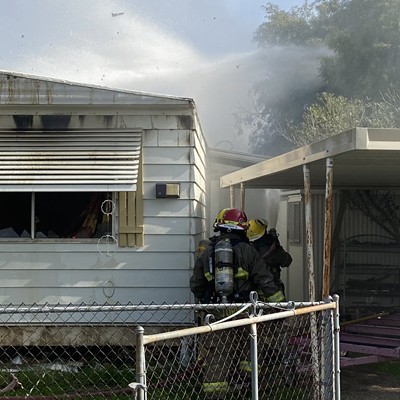Fifteen years of shuttling between Pennsylvania and Tucson is about to end for Jim and Janette Willenbecher, as retirement takes hold and they become permanent Tucson residents.
One of the final pieces in their relocation plan fell into place earlier this month when the Willenbechers' modest home on three acres in rural Pima County became part of the Northwest Fire/Rescue District.
"It's nice to know you're protected," said Jim Willenbecher, 69, who joined Northwest Fire on March 12 along with his brother-in-law Robert Cousy, who owns the adjoining property north of Willenbecher's property. "He had to join in for me to join in."
Willenbecher and Cousy are the latest landowners in their area to take advantage of a little-known state law that allows property owners who have land contiguous to an existing fire district's boundaries to join by signing an affidavit. All told, 23 properties have been added to the Northwest district since December. It now spans more than 140 square miles, from Pinal County to Gates Pass to the Catalina foothills.
Fire districts and other special taxing districts normally take in new territory through large-scale annexations, which require that more than 50 percent of the property owners in the area—as well as owners who control more than 50 percent of the collective property value in the area—sign a petition backing the annexation.
Northwest tried that last fall with a roughly 600-parcel area surrounding Camino de Mañana and Linda Vista Boulevard on the east side of Marana, an area that includes the Cousys and Willenbechers. That effort failed.
"There was a lot of vacant land in the area, and owners didn't have much interest in (fire) protection," said Carla Reece, Northwest's administrative manager. "Others were not interested in having a (larger) tax bill; they'd never had to pay before."
That's because for as long as seemingly anyone can remember, the area had been serviced by the Rural/Metro Fire Department, a private company that offers fire protection through a subscription service. (In fire districts, protection costs are based on property values and included in tax bills.)
Rural/Metro has been looking to phase out its coverage in the Willenbechers' area since 2010, mostly because there are few subscribers, and the nearest Rural/Metro station is near Orange Grove Road and Skyline Drive, more than 10 miles away.
"At one point and time, those homes were in the middle of nowhere," said Grant Cesarek, a Rural/Metro spokesman. "Now, with growth ... that's brought on more fire-department infrastructure placed over there."
Even though Northwest and other districts have closer fire stations, Rural/Metro is considered the default service provider and would need to take most calls, leading to longer response times and a decrease in safety.
A plan is now in place for uncovered properties in the area, Cesarek said: Any calls to 911 from the area are first routed to Rural/Metro, which may then contact Northwest or Mountain Vista—a fire district to the east—and ask if the district wants to take the call. If the district declines, Rural/Metro must respond.
"The closest, most-appropriate fire truck should provide service," Cesarek said.
It's a choice, though, and Northwest's Reece said her district has declined some calls.
"We have been requested a couple of times for minor things, like falls, but we turned them down," Reece said. "But if we felt there was a life at stake, you betcha—we'd jump in the trucks."
Reasons like these caused Willenbecher to opt for coverage from Northwest. He said that he and Cousy signed last year's annexation petition, and isn't sure why some of his neighbors didn't. If it was a money issue, he said, the cost to be protected far outweighs having to pay out-of-pocket for a service call.
"I chalked it up to being stubborn," Willenbecher said. "Because now they're sitting there with nothing. I pay more for car insurance."
Most calls in the area now end up being handled by Mountain Vista, a newer district formed in 2008 that contracts with Rural/Metro to provide firefighters and vehicles. The district's northwestern border touches the area, a fact which has led Chief Ed Wilkerson to consider having the properties added to Mountain Vista through annexation.
"We had been receiving phone calls from residents in the area, asking if we would consider that," Wilkerson said. "That was my introduction to this whole concept of folks out there not having organized fire protection. And as we started taking those requests, it was evident to me there was a lot of support for (annexation)."
Mountain Vista has started the annexation process, issuing a boundary-impact statement and setting up an April 3 public hearing for about 550 parcels in the Camino de Mañana area. Not included are the properties Northwest has already annexed, and two smaller groups of properties that Northwest still hopes to take in.
Wilkerson, who called Northwest a "phenomenal" district, said he thinks landowners might be more inclined to join Mountain Vista because of the cost difference. His district's tax rate is about $1.30 per $100 of secondary assessed property value, while Northwest's rate is $2.71 per $100.
"The last thing I want to see happen is for Northwest Fire and Mountain Vista to have it appear that somehow, we're in competition," Wilkerson said.
Though the various annexation efforts could ultimately lead to some funky coverage boundaries—including neighbors on opposite sides of a street being in different districts—those involved with fire protection say the main goal is to get residents covered.
"This isn't an us-versus-them thing," Northwest's Reece said. "This area has been without permanent dedicated fire service for over a year. We're really just looking to get these residents coverage when we can. We don't want anyone left uncovered."










